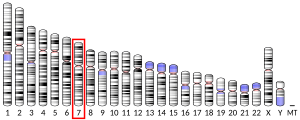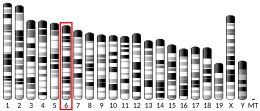EPHB6
Ephrin type-B receptor 6 is a protein that in humans is encoded by the EPHB6 gene.[5]
Ephrin receptors and their ligands, the ephrins, mediate numerous developmental processes, particularly in the nervous system. Based on their structures and sequence relationships, ephrins are divided into the ephrin-A (EFNA) class, which are anchored to the membrane by a glycosylphosphatidylinositol linkage, and the ephrin-B (EFNB) class, which are transmembrane proteins. The Eph family of receptors are divided into 2 groups based on the similarity of their extracellular domain sequences and their affinities for binding ephrin-A and ephrin-B ligands. Ephrin receptors make up the largest subgroup of the receptor tyrosine kinase (RTK) family. The ephrin receptor encoded by this gene lacks the kinase activity of most receptor tyrosine kinases and binds to ephrin-B ligands.[5]
References
[edit]- ^ a b c ENSG00000275482 GRCh38: Ensembl release 89: ENSG00000106123, ENSG00000275482 – Ensembl, May 2017
- ^ a b c GRCm38: Ensembl release 89: ENSMUSG00000029869 – Ensembl, May 2017
- ^ "Human PubMed Reference:". National Center for Biotechnology Information, U.S. National Library of Medicine.
- ^ "Mouse PubMed Reference:". National Center for Biotechnology Information, U.S. National Library of Medicine.
- ^ a b "Entrez Gene: EPHB6 EPH receptor B6".
Further reading
[edit]- Flanagan JG, Vanderhaeghen P (1998). "The ephrins and Eph receptors in neural development". Annu. Rev. Neurosci. 21: 309–45. doi:10.1146/annurev.neuro.21.1.309. PMID 9530499.
- Zhou R (1998). "The Eph family receptors and ligands". Pharmacol. Ther. 77 (3): 151–81. doi:10.1016/S0163-7258(97)00112-5. PMID 9576626.
- Holder N, Klein R (1999). "Eph receptors and ephrins: effectors of morphogenesis". Development. 126 (10): 2033–44. doi:10.1242/dev.126.10.2033. PMID 10207129.
- Wilkinson DG (2000). "Eph receptors and ephrins: regulators of guidance and assembly; Chapter: Eph receptors and ephrins: Regulators of guidance and assembly". Int. Rev. Cytol. International Review of Cytology. 196: 177–244. doi:10.1016/S0074-7696(00)96005-4. ISBN 978-0-12-364600-2. PMID 10730216.
- Xu Q, Mellitzer G, Wilkinson DG (2001). "Roles of Eph receptors and ephrins in segmental patterning". Philos. Trans. R. Soc. Lond. B Biol. Sci. 355 (1399): 993–1002. doi:10.1098/rstb.2000.0635. PMC 1692797. PMID 11128993.
- Wilkinson DG (2001). "Multiple roles of EPH receptors and ephrins in neural development". Nat. Rev. Neurosci. 2 (3): 155–64. doi:10.1038/35058515. PMID 11256076. S2CID 205014301.
- Bonaldo MF, Lennon G, Soares MB (1997). "Normalization and subtraction: two approaches to facilitate gene discovery". Genome Res. 6 (9): 791–806. doi:10.1101/gr.6.9.791. PMID 8889548.
- Matsuoka H, Iwata N, Ito M, et al. (1997). "Expression of a kinase-defective Eph-like receptor in the normal human brain". Biochem. Biophys. Res. Commun. 235 (3): 487–92. doi:10.1006/bbrc.1997.6812. hdl:20.500.14094/D1001814. PMID 9207182.
- Ephnomenclaturecommittee (1997). "Unified nomenclature for Eph family receptors and their ligands, the ephrins. Eph Nomenclature Committee". Cell. 90 (3): 403–4. doi:10.1016/S0092-8674(00)80500-0. PMID 9267020. S2CID 26773768.
- Hock B, Böhme B, Karn T, et al. (1998). "PDZ-domain-mediated interaction of the Eph-related receptor tyrosine kinase EphB3 and the ras-binding protein AF6 depends on the kinase activity of the receptor". Proc. Natl. Acad. Sci. U.S.A. 95 (17): 9779–84. Bibcode:1998PNAS...95.9779H. doi:10.1073/pnas.95.17.9779. PMC 21413. PMID 9707552.
- Munthe E, Rian E, Holien T, et al. (2000). "Ephrin-B2 is a candidate ligand for the Eph receptor, EphB6". FEBS Lett. 466 (1): 169–74. doi:10.1016/S0014-5793(99)01793-7. PMID 10648835. S2CID 40328521.
- Shimoyama M, Matsuoka H, Tamekane A, et al. (2000). "T-cell-specific expression of kinase-defective Eph-family receptor protein, EphB6 in normal as well as transformed hematopoietic cells". Growth Factors. 18 (1): 63–78. doi:10.3109/08977190009003234. hdl:20.500.14094/D1002141. PMID 10831073. S2CID 9397812.
- Tang XX, Zhao H, Robinson ME, et al. (2000). "Implications of EPHB6, EFNB2, and EFNB3 expressions in human neuroblastoma". Proc. Natl. Acad. Sci. U.S.A. 97 (20): 10936–41. Bibcode:2000PNAS...9710936T. doi:10.1073/pnas.190123297. PMC 27127. PMID 10984508.
- Luo H, Wan X, Wu Y, Wu J (2001). "Cross-linking of EphB6 resulting in signal transduction and apoptosis in Jurkat cells". J. Immunol. 167 (3): 1362–70. doi:10.4049/jimmunol.167.3.1362. PMID 11466354.




